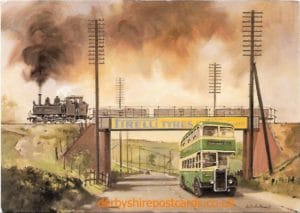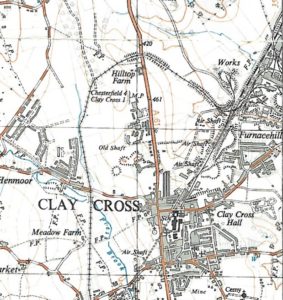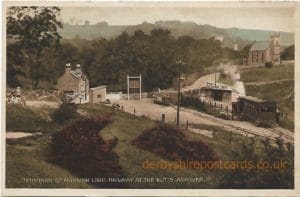Ashover Light Railway passed through Old Tupton.
The line started at Clay Cross Works, just above the northern portal of the Clay Cross Tunnel. From here, Ashover Light Railway swung northwards out of the town, then curved westwards through 180 degree to avoid going through Clay Cross town centre. The problem with this route was the Chesterfield Road, now the A61, and crossing it required a steel girder bridge spanning 45 feet. The height had to be 16 feet above road level, which required a half-mile long approach embankment to be built. The bridge and embankment were the only major pieces of engineering on the entire route between Clay Cross and Ashover. Shortly after the opening of the railway, the Pirelli Tyre Company at Burton-upon-Trent had a large advertisement painted on the bridge therefore it became known as ‘The Pirelli Bridge’.

Ashover Light Railway crossing the Pirelli Bridge, Derby Road
Several stations were provided along the line, with the main terminus and headquarters being Clay Cross & Egstow within the Clay Cross Works. Four further stations named Chesterfield Road, Holmgate, Springfield and Clay Lane were erected within the town boundaries of Clay Cross, with the next station being at Stretton. At this point the line was still continuing southwards, but soon swung north-westwards again to follow the picturesque course of the River Amber as far as Ashover. Stations along this section were Hurst Lane, Woolley, Dalebank, Milltown, Fallgate, Salter Lane (for Ashover), and Ashover Butts.

Ashover Light Railway route on OS map
The Ashover Light Railway was a 1 ft 11 ½ in (597 mm) narrow gauge railway. It was built by the Clay Cross Company to transport minerals from Ashover quarries.

Terminus of Ashover Light Railway at the Butts, Ashover
As Clay Cross Company continued to develop its mining interests it purchased the Overton Estate at Fallgate in 1918 with the aim of extracting minerals. An order under the Light Railways Act was obtained in 1918 to build a standard gauge railway between the Midland Railway station at Stretton and Ashover, with a 2 ft (610 mm) gauge rope-worked mineral railway serving Alton colliery. This railway was not built because the cost estimates were too high. Instead in 1920 H. F. Stephens, the consulting engineer for the line, proposed building the entire railway to 2 ft gauge. This considerably reduced the costs of construction and the plan was approved.
Construction started in 1922 and the railway opened to goods traffic in 1924. The formal opening to passenger traffic took place in March 1925. The line was built using surplus equipment from the War Department Light Railways. Although the line was built principally to carry mineral traffic, its passenger service proved successful during the mid-1920s, but competition from buses saw numbers decline and Winter services ceased in 1934. All passenger services were withdrawn in 1936.
The mineral traffic continued but the railway declined through the 1940s. In 1949 the railway’s last remaining contract with Butts quarry was terminated and the quarry closed in 1950. The railway closed on 31 March 1950. Most of the rail remained in place through October of that year when a last inspection trip was made. After that the majority of the railway was lifted. However a short length was left in place around the Fallgate works. This remnant track continued to be used until 1968.
